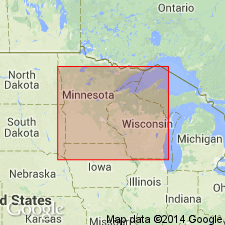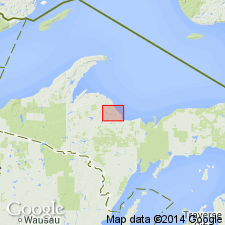
- Usage in publication:
-
- Kitchi schists*
- Modifications:
-
- Named
- Dominant lithology:
-
- Schist
- Conglomerate
- AAPG geologic province:
-
- Lake Superior region
Summary:
Archean greenstone-schists that contain pebble-like bodies are best developed "on the Kitchi Hills, in the neighborhood of Deer Lake, northwest of Ishpeming, and hence they are called the Kitchi schists." Kitchi Hills shown in sec 33, T48N, R27W, Marquette Co., MI (Lake Superior region). Formation is mapped (pl XIII) in east-west belt (2-31/2 mi wide) from east line of R27W to west line of secs 25 and 36; is thought to pass into Mona schists (new) to east; in contact with coarse gneissoid granite to west; is bounded to north by Algonkian deposits of Silver Lake area and to south by those of Marquette range. Comprised of coarse conglomeratic green schist, nonconglomeratic green schist, and sericite-schist; rocks are metamorphosed basic tuffs that have preserved their tuffaceous character to a greater degree than the Mona schists. Conglomeratic schists resemble schistose sedimentary conglomerates, the pebble derived from a fine-grained, purplish-green rock in a matrix of green schist; they have been called the Deer Lake conglomerates. Nonconglomeratic beds are like the matrix of the conglomeratic beds, except that small, light-colored feldspar grains are scattered through (these are often drawn out into lenses or sheet-like layers giving a gneissic aspect). Sericite-schist is a pink to white, platy and schistose rock with very pronounced soapy feel. Probably equivalent to Mona schists to the east. Considered pre-Algonkian.
Source: GNU records (USGS DDS-6; Reston GNULEX).

- Usage in publication:
-
- Kitchi Schist*
- Modifications:
-
- Overview
- Dominant lithology:
-
- Schist
- Pyroclastics
- AAPG geologic province:
-
- Lake Superior region
Summary:
Is lower Precambrian, mainly pyroclastic, formation mapped north of Teal Lake in southwest part of Negaunee quadrangle, Marquette Co, MI (Lake Superior region). Kitchi Hills, for which the unit was named by Van Hise and Bayley (1895), are about 3 mi west of this quad. Map unit described as dark-green fragmental metavolcanic rocks of latite to rhyodacite composition. Large, often rounded pyroclasts in tuffaceous matrix. Crystal tuff and crystal-lithic tuff common. Possibly contemporaneous with lower member of Mona Schist. Maximum thickness is 4,500 ft. North boundary between the Kitchi and the Mona appears conformable, but contact not seen; possible intertonguing of the two obscured by regional metamorphism. South boundary of Kitchi Schist is Carp River Falls shear zone. Northeast and east boundary obscured by alluvium and glacial material; map pattern suggests discordant contact.
Source: GNU records (USGS DDS-6; Reston GNULEX).

- Usage in publication:
-
- Kitchi Schist*
- Modifications:
-
- Overview
- AAPG geologic province:
-
- Lake Superior region
Summary:
Is oldest rock unit assigned to greenstone-granite terrane in Marquette district, northwestern MI in Lake Superior region. Consists of [metamorphosed] mafic flows and tuffs which grade upward into coarse [metamorphosed] volcanic breccia of felsic composition. Lower part contains Deer Lake Peridotite. Is overlain by Mona Schist. Correlation chart. Is assigned a Late Archean age.
Source: GNU records (USGS DDS-6; Reston GNULEX).

- Usage in publication:
-
- Kitchi Formation*
- Modifications:
-
- Revised
- AAPG geologic province:
-
- Wisconsin arch
Summary:
Kitchi Schist is here revised to Kitchi Formation as rocks are heterogeneous and have recognizable parent lithologies. The Kitchi is divided into three informal units: 1) basal flow unit (metabasalt and metagabbro of Clark and others, 1975, and the mafic-ultramafic complex of Cannon and Klasner, 1977); 2) tuff unit (complex of dacitic tuff, flows, and probably hypabyssal intrusive rocks within the Kitchi Schist of Clark and others, 1975); and 3) lahar unit (agglomerate within Kitchi Schist of Clark and others, 1975), which occurs as interlayers in the tuff unit. Rocks in the westernmost part of the southwest block are here assigned to the basalt flow unit. These were originally termed metagabbro by Clark and others (1975) in the Negaunee SW 7.5-min quad and the mafic-ultramafic complex by Cannon and Klasner (1977) in the Diorite 7.5-min quad.
Source: GNU records (USGS DDS-6; Reston GNULEX).
For more information, please contact Nancy Stamm, Geologic Names Committee Secretary.
Asterisk (*) indicates published by U.S. Geological Survey authors.
"No current usage" (†) implies that a name has been abandoned or has fallen into disuse. Former usage and, if known, replacement name given in parentheses ( ).
Slash (/) indicates name conflicts with nomenclatural guidelines (CSN, 1933; ACSN, 1961, 1970; NACSN, 1983, 2005, 2021). May be explained within brackets ([ ]).

